 Database
Database
 Redis
Redis
 Detailed introduction to the concepts, principles and usage scenarios of message queues (with cases)
Detailed introduction to the concepts, principles and usage scenarios of message queues (with cases)
Detailed introduction to the concepts, principles and usage scenarios of message queues (with cases)

As we all know, when designing a website, you will encounter "group text messages" to users, "a large number of logs in the order system", "flash sale design", etc. The server cannot handle these. This kind of instantaneous burst of pressure requires the help of "message queue" to ensure the normal and effective use of the system. This article mainly studies through the idea of message queue.
Mainly understand the following knowledge:
1. What is a queue and what can it do?
2. What are the application scenarios for alignment?
3. How to use queues to uncouple services?
4. How to use Redis queue to eliminate high pressure?
5. How to use the professional alignment system RabbitMQ?
The main contents are summarized as follows
@The concept, principle and scenario of message queue
@Decoupling case: queue processing order system and distribution system
@Traffic Peak Shaving Case: Redis’s List Type Realizes Flash Sales
@RabbitMQ: A More Professional Message System Implementation Solution
1. Understanding the Message Queue
1.1 Message queue concept
Essentially, message queue is a middleware with a queue structure, which means that the message can be returned directly after being put into this middleware. The system does not need to process it immediately, but another program will read the data and process it one by one in order.
That is to say, when you encounter a situation that is extremely concurrent and takes a long time, and you do not need to return the processing results immediately, using message queues can solve such problems.
1.2 Core structure

Enqueues messages by a business system, inserts messages into the message queue one by one, and directly returns a successful result after the insertion is successful. There will be a message processing system in the future, which will take out and process the records in the message system one by one, completing a dequeuing process.
1.3 Application Scenario
Data redundancy: For example, in the order system, strict data conversion and recording are required in the future. The message queue can store these data persistently in the queue, and then there are orders , the subsequent processing program obtains it, and after the subsequent processing is completed, the record is deleted to ensure that each record can be processed.
System decoupling: After using the message system, the enqueuing system and the dequeuing system are separated, which means that as long as it crashes one day, it will not affect the normal operation of the other system.
Traffic peak shaving: For example, flash sales and rush sales, we can use message queues in conjunction with caching, which can effectively withstand the amount of instantaneous visits and prevent the server from being overwhelmed and causing a crash.
Asynchronous communication: The message itself can be returned directly after being queued.
Scalability: For example, the order queue can not only process orders, but can also be used by other businesses.
Sorting Guarantee: Some scenarios need to be processed in the order of products, such as single in and single out to ensure that data is processed in a certain order. It is possible to use message queues.
The above are common usage scenarios of message queue. Of course, message queue is just a middleware and can be used in conjunction with other products.
1.4 Common queue implementation advantages and disadvantages
Queue medium
1. Database, such as mysql (high reliability, easy to implement, slow speed)
2 , cache, such as redis (fast, low efficiency when a single message package is too large)
3, message system, such as rabbitMq (highly professional, reliable, high learning cost)
Message Processing trigger mechanism
1. Infinite loop reading: easy to implement, unable to recover in time in case of failure; (more suitable for flash sale, more centralized, centralized operation and maintenance)
2. Scheduled tasks : Pressure is evenly distributed, with a processing upper limit; currently a popular processing trigger mechanism. (The only disadvantage is that you need to pay attention to the interval and data. Don't wait until the previous task is not completed and the next task starts again)
3. Daemon process: similar to php-fpm and php-cg, requires shell basics
2. Decoupling Case: Queue Processing "Order System" and "Distribution System"
For the order process, We can design two systems, one is the "order system" and the other is the "delivery system". We should all have seen it when shopping online. After I submit an order, I can see in the background that my goods are being delivered. middle. At this time, a "delivery system" needs to be involved.
If we design the "order system" and "delivery system" together when doing the architecture, there will be some problems. First of all, for the order system, the pressure on the system will be relatively high, but " The distribution system" does not necessarily have to respond immediately to these pressures.
Secondly, we don’t want the delivery system to malfunction after the order system malfunctions, which will affect the normal operation of both systems at the same time. So we hope to decouple these two systems. After the two systems are separated, we can communicate between the two systems through an intermediate "queue table".
2.1 Architecture design
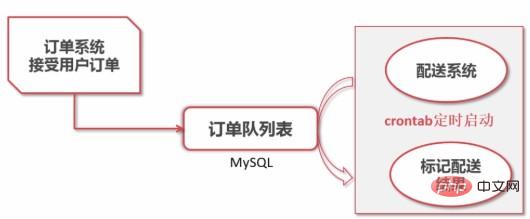
1. First, the order system will receive the user's order, and then process the order.
2. These order information will then be written to the queue table. This queue table is the key to communicating between the two systems.
3. A program executed regularly by the distribution system reads the queue table for processing.
4. After processing by the distribution system, the processed records will be marked.
2.2 Program flow
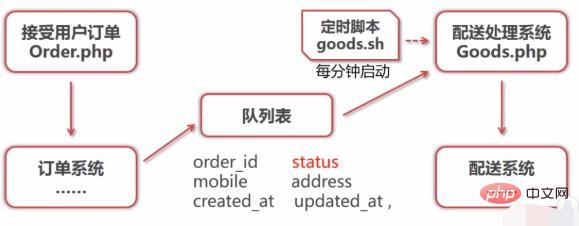
#3. Traffic peak clipping case: Redis’s list type realizes flash sales
redis Based on memory, its speed will be very fast. Redis is a very good supplement to the database because it is durable. Redis will periodically write data to the hard disk, so it does not have to worry about power outages. In this respect, it has more advantages than another cache memcache. In addition, redis provides five data types (string, doubly linked list, hash, set, ordered set)
In general, do flash sales Redis is a good choice for cases where cases, rush purchases, and cases that require queuing are instantly higher than yours.
3.1 The list type in the redis data type
The list in redis is a doubly linked list, and data can be appended from the head or tail.
* LPUSH/LPUSHX: Insert the value into the head of the (/existing) list
* RPUSH/RPUSHX: Insert the value into the tail of the (/existing) list
* LPOP: Remove and get the first element of the list
* RPOP: Remove and get the last element of the list
* LTRIM: Keep the elements in the specified range
* LLEN: Get the length of the list
* LSET: Set the value of the list element by index
* LINDEX: Get the element in the list by index
* LRANGE: Get the elements within the specified range of the list
3.2 Architecture design
A simple structure flash kill program design.
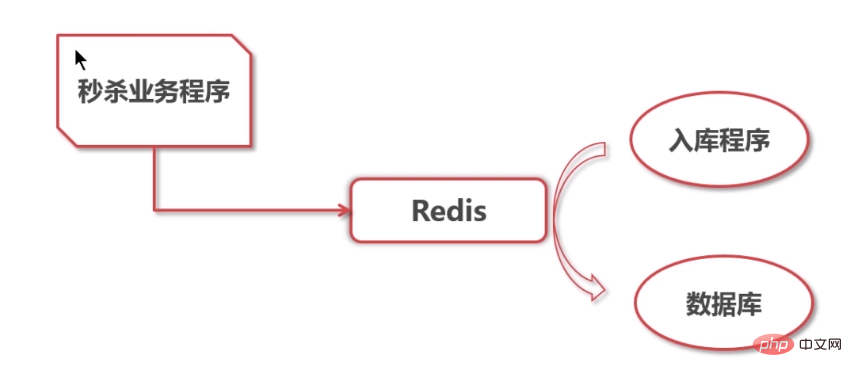
#1. First record which user participated in the flash sale and record his time.
2. Save the user's ID in the redis list and let it queue up. If it is stipulated that only the first 10 users can successfully participate, if the number in the list is enough, it will not be allowed to continue to add data. In this way, the length of the redis list will only be 10
3. Finally, slowly write the data in redis into the database to reduce the pressure on the data
3.3 Code-level design
1. When the user starts the flash sale, write the request of the flash sale program into Redis (uid, time_stamp).
2. If it is stipulated that only 10 people can succeed in the flash sale, check the length of the data stored in Redis. If it exceeds the upper limit and discard it directly, it means the flash sale is completed.
3. Finally, the 10 pieces of data stored in Redis are processed in an infinite loop, and then the data is slowly fetched and stored in the mysql database.
In the flash sale area, the pressure on the database is particularly high. If we do not have such a design, it will cause a writing bottleneck in MySQL. We use a queue list in Redis, and then put the flash sale request into Redis. Finally, we slowly write the data into the database through the warehousing program. In this way, the traffic can be balanced and there will be no impact on mysql. Too much pressure.
4. RabbitMQ
Here we will explain some uses of RabbitMQ. First of all, when we talked about the flash sale case before, we mentioned the lock mechanism to prevent other programs from processing the same record. If our system architecture is very complex, there are multiple programs reading a queue in real time, or I have multiple sending programs that operate one or more queues at the same time, and I even want these programs to be distributed on different machines. In this case, using redis queue is somewhat inadequate. What to do at this time? We need to introduce some more professional message queue systems, which can better solve the problem.
4.1 The architecture and principles of RabbitMQ
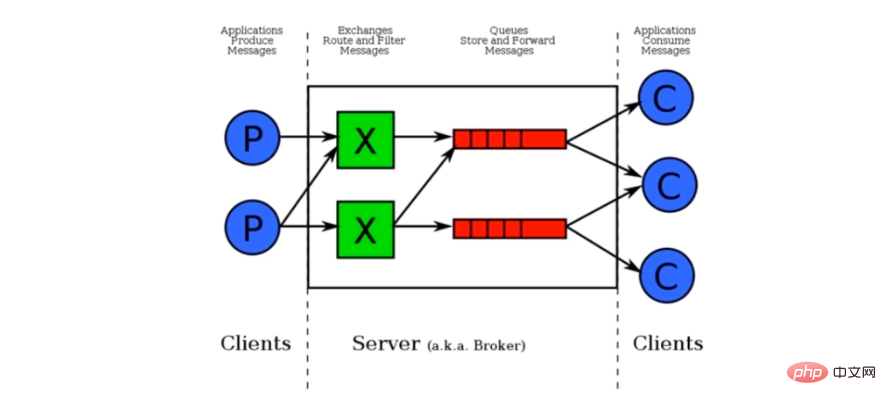
Work queue
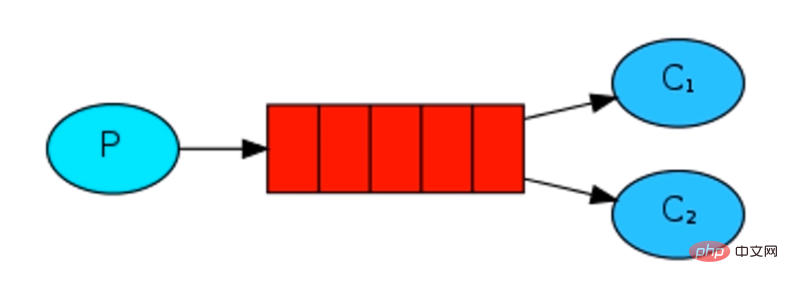
This not only solves the decoupling between producers and consumers, but also enables the sharing of consumers and tasks, reducing the pressure on the server.
5. Summary
The above mainly focuses on learning the concepts, principles, and scenarios of message queues. Decoupling cases and understanding the simple use of RabbitMQ.
6. Question
What is the biggest difference between redis and message server selection.
My understanding is that Redis processes requests one by one. Redis is a single thread. It is different from the message server IO implementation. One is synchronous and the other is asynchronous, while redis uses synchronous blocking, while the message server Use asynchronous non-blocking.
For more Redis related knowledge, please visit the Redis usage tutorial column!
The above is the detailed content of Detailed introduction to the concepts, principles and usage scenarios of message queues (with cases). For more information, please follow other related articles on the PHP Chinese website!

Hot AI Tools

Undresser.AI Undress
AI-powered app for creating realistic nude photos

AI Clothes Remover
Online AI tool for removing clothes from photos.

Undress AI Tool
Undress images for free

Clothoff.io
AI clothes remover

Video Face Swap
Swap faces in any video effortlessly with our completely free AI face swap tool!

Hot Article

Hot Tools

Notepad++7.3.1
Easy-to-use and free code editor

SublimeText3 Chinese version
Chinese version, very easy to use

Zend Studio 13.0.1
Powerful PHP integrated development environment

Dreamweaver CS6
Visual web development tools

SublimeText3 Mac version
God-level code editing software (SublimeText3)

Hot Topics
 PHP's Purpose: Building Dynamic Websites
Apr 15, 2025 am 12:18 AM
PHP's Purpose: Building Dynamic Websites
Apr 15, 2025 am 12:18 AM
PHP is used to build dynamic websites, and its core functions include: 1. Generate dynamic content and generate web pages in real time by connecting with the database; 2. Process user interaction and form submissions, verify inputs and respond to operations; 3. Manage sessions and user authentication to provide a personalized experience; 4. Optimize performance and follow best practices to improve website efficiency and security.
 PHP and Python: Different Paradigms Explained
Apr 18, 2025 am 12:26 AM
PHP and Python: Different Paradigms Explained
Apr 18, 2025 am 12:26 AM
PHP is mainly procedural programming, but also supports object-oriented programming (OOP); Python supports a variety of paradigms, including OOP, functional and procedural programming. PHP is suitable for web development, and Python is suitable for a variety of applications such as data analysis and machine learning.
 PHP and Python: Code Examples and Comparison
Apr 15, 2025 am 12:07 AM
PHP and Python: Code Examples and Comparison
Apr 15, 2025 am 12:07 AM
PHP and Python have their own advantages and disadvantages, and the choice depends on project needs and personal preferences. 1.PHP is suitable for rapid development and maintenance of large-scale web applications. 2. Python dominates the field of data science and machine learning.
 Choosing Between PHP and Python: A Guide
Apr 18, 2025 am 12:24 AM
Choosing Between PHP and Python: A Guide
Apr 18, 2025 am 12:24 AM
PHP is suitable for web development and rapid prototyping, and Python is suitable for data science and machine learning. 1.PHP is used for dynamic web development, with simple syntax and suitable for rapid development. 2. Python has concise syntax, is suitable for multiple fields, and has a strong library ecosystem.
 PHP: Handling Databases and Server-Side Logic
Apr 15, 2025 am 12:15 AM
PHP: Handling Databases and Server-Side Logic
Apr 15, 2025 am 12:15 AM
PHP uses MySQLi and PDO extensions to interact in database operations and server-side logic processing, and processes server-side logic through functions such as session management. 1) Use MySQLi or PDO to connect to the database and execute SQL queries. 2) Handle HTTP requests and user status through session management and other functions. 3) Use transactions to ensure the atomicity of database operations. 4) Prevent SQL injection, use exception handling and closing connections for debugging. 5) Optimize performance through indexing and cache, write highly readable code and perform error handling.
 Why Use PHP? Advantages and Benefits Explained
Apr 16, 2025 am 12:16 AM
Why Use PHP? Advantages and Benefits Explained
Apr 16, 2025 am 12:16 AM
The core benefits of PHP include ease of learning, strong web development support, rich libraries and frameworks, high performance and scalability, cross-platform compatibility, and cost-effectiveness. 1) Easy to learn and use, suitable for beginners; 2) Good integration with web servers and supports multiple databases; 3) Have powerful frameworks such as Laravel; 4) High performance can be achieved through optimization; 5) Support multiple operating systems; 6) Open source to reduce development costs.
 PHP and Python: A Deep Dive into Their History
Apr 18, 2025 am 12:25 AM
PHP and Python: A Deep Dive into Their History
Apr 18, 2025 am 12:25 AM
PHP originated in 1994 and was developed by RasmusLerdorf. It was originally used to track website visitors and gradually evolved into a server-side scripting language and was widely used in web development. Python was developed by Guidovan Rossum in the late 1980s and was first released in 1991. It emphasizes code readability and simplicity, and is suitable for scientific computing, data analysis and other fields.
 PHP vs. Python: Use Cases and Applications
Apr 17, 2025 am 12:23 AM
PHP vs. Python: Use Cases and Applications
Apr 17, 2025 am 12:23 AM
PHP is suitable for web development and content management systems, and Python is suitable for data science, machine learning and automation scripts. 1.PHP performs well in building fast and scalable websites and applications and is commonly used in CMS such as WordPress. 2. Python has performed outstandingly in the fields of data science and machine learning, with rich libraries such as NumPy and TensorFlow.





